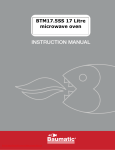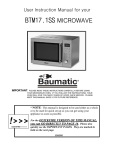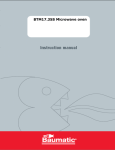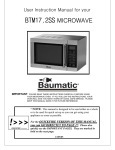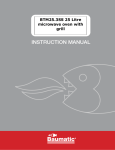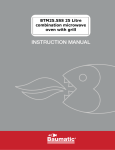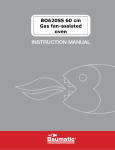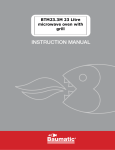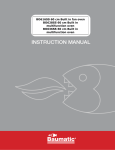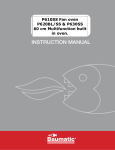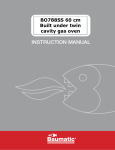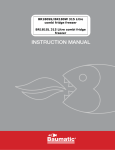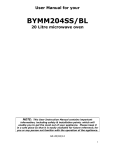Download Baumatic BTM17.2SS User manual
Transcript
BTM17.4SS 17 Litre microwave e 1 User Manual for your Baumatic BTM17.4SS 17 Litre microwave oven NOTE: This User Instruction Manual contains important information, including safety & installation points, which will enable you to get the most out of your appliance. Please keep it in a safe place so that it is easily available for future reference; for you or any person not familiar with the operation of the appliance. DD 06/09/10 2 Contents Environmental note 4 Important safety information 5–8 Specifications Product dimensions Product specifications Description of the appliance Control panel The turntable 9 - 11 9 9 10 11 11 Using your microwave Setting the clock Before first use Cooking food During operation Quick start Automatic defrost programmes Automatic cooking programmes Setting multiple cooking phases Setting a delay start Safety lock Microwave cooking guidelines Materials you can use in a microwave oven Materials not to be placed in a microwave oven Defrosting guidelines Defrosting table 12 12 12 13 14 14 15 16 17 18 19 19 20 21 21 22 Cleaning and maintenance The appliance exterior The appliance interior Rotating plate and rotating base General cleaning advice 23 - 24 23 23 23 - 24 24 Installation Fitting the distance limiter Positioning Electrical connection 24 – 27 25 25 26 - 27 Troubleshooting 27 - 28 Contact details 29 - 23 - 14 - 17 - 19 - 20 - 21 – 22 - 23 3 Environmental note o The packaging materials that Baumatic uses are environmentally friendly and can be recycled. o Please discard all packaging material with due regard for the environment. 4 IMPORTANT SAFETY INFORMATION Your safety is of the utmost importance to Baumatic. Please make sure that you read this instruction booklet before attempting to install or use the appliance. If you are unsure of any of the information contained in this booklet, please contact the Baumatic Advice Line. General Information o This appliance is designed for domestic household use. It can NOT be used as a built-in microwave and must be used as a freestanding appliance. o You should only operate the appliance when the turntable and turntable support are in position. o You should only use ovenware that is suitable for being used in a microwave. o To prevent corrosion occurring due to moisture/condensation, the cavity and the door of the microwave should be wiped dry after each use of the appliance. o The appliance must not be left unattended if you are heating or cooking food in containers that are made of paper, plastic or other flammable materials. If left unattended, they could pose a fire hazard. o If you notice smoke coming from the appliance, you should keep the door of the microwave closed and then disconnect it from your mains supply. DO NOT use your microwave oven, if you think it is not operating correctly. Installation o IMPORTANT: Only the freestanding installation sanctioned by Baumatic and outlined in this manual should be followed. o Ventilation gaps MUST be left around the microwave; at least 10 cm to the rear, 5 cm to both sides and 20 cm above the appliance. o The use of this appliance for any other purpose or in any other environment without the express agreement of Baumatic Ltd. will invalidate any warranty or liability claim. 5 o Your new appliance is guaranteed against electrical or mechanical defects, subject to certain exclusions that are noted in Baumatic’s Conditions Of Guarantee. The foregoing does not affect your statutory rights. Service o Your microwave complies with all relevant safety standards. In order for it to continue to operate safely, only an engineer that is approved by the Baumatic Customer Care Department should work on the appliance. o IMPORTANT: It is dangerous for a non qualified person to work on the appliance, in particular if they remove the cover that provides protection against exposure to microwave energy. o If you notice that the door seal, door surfaces, power cord and plug are damaged. You should stop using the appliance, disconnect it from the mains supply and contact the Baumatic Customer Care Department. o Only genuine Baumatic spare parts should be fitted to your appliance. These can be obtained from the Baumatic Spares Department. Warning and safety instructions o This appliance complies with all current European safety legislation. Baumatic do wish to emphasise that this compliance does not remove the fact that the appliance surfaces will become hot during use and retain heat after operation. o DO NOT place anything between the door and the door frame. o DO NOT store anything that is flammable inside of the microwave. When it is switched on, the items could catch fire. o DO NOT switch the appliance on if there is no food or liquid inside of the microwave. If you run the microwave whilst it is empty, there is a chance that it will overload. o The door seals and the door surfaces should ALWAYS be kept clean and free from debris. 6 Child Safety o Baumatic strongly recommend that babies and young children are prevented from being near to the appliance and not allowed to touch the appliance at any time. o If it is necessary for younger family members to be in the kitchen, please ensure that they are kept under close supervision at all times. o IMPORTANT: This appliance should only be operated by adults. You SHOULD NOT allow young children to use the microwave without supervision. Older children should only operate the appliance if they have been thoroughly instructed on how to use the microwave and the consequences of improper usage. General Safety o Do not allow electrical fittings or cables to come into contact with areas on the appliance that get hot. o Do not use the appliance to heat the room it is located in. o Do not use the appliance to dry paper, textiles or animals. o Do not install the appliance next to curtains or soft furnishings. o Do not use the appliance to heat unopened bottles or cans etc. o Do not heat cooking oil or liquid containing alcohol, as there is the chance of spontaneous combustion. o Do not boil eggs or similar foods in their shells, otherwise they may burst. It is possible to poach eggs in your microwave, providing you prick the yolks first. o Do not attempt to lift or move cooking appliances by using the oven door, as this may cause damage to the appliance or result in injury to the person lifting the appliance. 7 Cleaning o Cleaning of the oven should be carried out on a regular basis. o Great care should be taken whilst using this appliance and when following the cleaning procedure. o IMPORTANT: The appliance must be disconnected from the mains before following the cleaning procedure. Installation This appliance must be correctly installed by a suitably qualified person, strictly in accordance with the manufacturer’s instructions. o Baumatic Ltd. declines any responsibility for injury or damage, to person or property, as a result of improper use or installation of this appliance. o Heat, steam and moisture will be created during use of the appliance, take care to avoid injury and ensure that the room is adequately ventilated. If the appliance is going to be used for prolonged periods of time, then additional ventilation may be required. o Please consult with your qualified installer if you are in any doubt about the amount of ventilation that you will require. Declaration of conformity o CE: Appliance conforming to the European directives 89/336/EEC, 93/68/EEC, 73/23/EEC and subsequent revisions and “RoHS” directive 2002/95/CE.* o The manufacturer declares that the oven is built using certified materials and requires the appliance to be installed in accordance with the standards currently in force. This appliance must be used by a trained person for domestic purposes only. * The RoHS directive stands for “the restriction of the use of certain hazardous substances in electrical and electronic equipment”. This directive bans the placing on the EU market of new electrical and electronic equipment containing more than the agreed levels of lead, cadmium, mercury, hexavalent chromium, polybrominated biphenyl (PBB) and polybrominated diphenyl ether (PBDE) flame retardants. 8 Specifications Product dimensions* Height: Width: Depth: 295 mm 458 mm 339 mm * Please refer to the installation instructions contained in this user manual, to see the ventilation gaps you will need to leave around the appliance. Product specifications o o o o o o o o o o o 5 power levels Push button control operation Safety lock Interior light LED display LED full programmer Defrosting by weight mode Stainless steel exterior and interior Viewing window Capacity: 17 litres Microwave output: 800 W For future reference please record the following information which can be found on the rating plate and the date of purchase which can be found on your sales invoice. The rating plate for your oven can be located by opening the microwave oven door and looking on the right hand side of the chassis and/or on the rear of the appliance. Model Number ………………………………. Serial Number ………………………………. Date of Purchase ………………………………. 9 Description of the appliance 1) Microwave door 2) Door catches 3) Cavity 4) Slot for rotating base 5) Rotating plate 6) Rotating base 7) Door open button 8) Control buttons 9) LED display 10) Microwave housing 11) Wave guide cover (see opposite) 10 Control panel A) Micro power button (power level button) B) Express button (quick start button) C) Preset clock button (delayed start button) D) LED display E) Stop clear button F) Instant start button (start button) G) Auto defrost button H) Auto cooking button I) Time weight button The turntable o Never place the rotating plate upside down. o The rotating plate and rotating base MUST always be used during cooking. o All food and food containers must ALWAYS be placed on the rotating plate during cooking. o If the rotating plate or rotating base cracks or breaks, it must be replaced immediately. Genuine Baumatic parts can be obtained from the Baumatic Spares Department. 11 Using your microwave Setting the clock o When your microwave is connected to the power supply, you can set the clock to the correct time of day. You will need to open the microwave door to access the control panel. o The entire LED display will flash and then the “:” symbol on its own. You should press the preset clock button (C) to set the time of day. The appliance has a 24 hour clock. o Press the time weight button (I) and the hour digits will start to flash. Continue to press the time weight button until the correct hour digit is displayed. o Press the preset clock button again to confirm the hour time. The minute digits will start to flash. Continue to press the time weight button until the correct minute digit is displayed. o Press the preset clock button for a third time to confirm the minute time. The digits on the LED display will stop flashing and the time of day is set. o If you do not set the time of day, every time you connect your microwave to the power supply, you will need to press the stop clear button (E) once before you can use the microwave. Before first use o To remove any residue from the oven that may have been left from the manufacturing process, you should place a cup that is half filled with water in the microwave. o Set the microwave on its highest power level for 2 minutes. o The oven cavity and outside of the appliance should be cleaned with warm soapy water, using either a sponge or soft cloth. No abrasive cleaners should be used. The appliance should be thoroughly dried afterwards. o We would recommend that an appropriate stainless steel cleaner and polish is regularly used on the stainless steel surfaces of this appliance. 12 Cooking food o Once the clock has been set, your microwave is then ready to use. o Use the door open button (7) to open the door of the microwave. o Check that the rotating plate and rotating base are correctly assembled in the cavity. o Place whatever you are cooking in the centre of the microwave cavity. IMPORTANT: You will need to leave the microwave door open to access the control panel and set the required cooking time and power. o Press the micro power button (A) to set the required power level, 100P, 80P, 60P, 40P, 20P will appear on the LED display. LED Display 100P 80P 60P 40P 20P Microwave power level Full power (100%) Medium/high power (80%) Medium power (60%) Medium/low power (40%) Low power (20%) Power level suitable for… Meat and vegetables Eggs, fish, congee, rice, soup Steaming food Defrosting food Keeping food warm o Once the correct power level is displayed, press the time weight button (I) to set the cooking time. The maximum cooking time that can be set is 60 minutes. o Close the microwave door. IMPORTANT: You should make sure that the door of the microwave is shut securely. Press the instant start button (F) and the microwave will start to heat. o At the end of the cooking time, your microwave will give an audible signal and the LED display will show the word “END”. o The audible signal will be repeated every 3 minutes, until the stop clear button is pressed or the door is opened by pressing the door open button. o IMPORTANT: The inside of the microwave and the food that you have been cooking may be extremely hot. So care should be taken when removing items from the microwave. We would recommend that you use an oven glove. 13 o After the food has been removed from the microwave, you should make sure that the door is closed. During operation o To interrupt the cooking process to turn or stir the food, press the stop clear button (E) once. o Press the door open button (7) to open the door of the microwave. o Whilst the door is open, it is possible to stir the food stuffs that you are cooking or adjust its position on the rotating plate. o To restart the cooking process, close the door and then press the instant start button once. o If you wish to remove the food before the cooking time has completed, then press the stop clear button twice to cancel the cooking operation. Quick start o Use the door open button (7) to open the door of the microwave. o Check that the rotating plate and rotating base are correctly assembled in the cavity. o Place whatever you are heating in the centre of the microwave cavity. IMPORTANT: You will need to leave the microwave door open to access the control panel and set the required quick start program. o Press the express button (B) and the LED display will show the options 0:30, 1:00, 1:30. Heating time period LED display 0:30 30 seconds 1:00 1 minute 1:30 1 minute and 30 seconds o Close the microwave door. IMPORTANT: You should make sure that the door of the microwave is shut securely. Press the instant start button (F) and the microwave will start to heat. This feature allows you to heat a cup of water or beverage conveniently, it is not necessary to set the power level or cooking time. 14 Automatic defrost programmes o Use the door open button (7) to open the door of the microwave. o Check that the rotating plate and rotating base are correctly assembled in the cavity. o Place whatever you are defrosting in the centre of the microwave cavity. IMPORTANT: You will need to leave the microwave door open to access the control panel and set the required defrost program and food weight. o Press the auto defrost button (G) and the LED display will show d.1, d.2, d.3. LED display d.1 d.2 d.3 Weight range Defrost level suitable for… (kg) Defrosting meat 0.1 – 2.0 Defrosting poultry 0.2 – 3.0 Defrosting seafood 0.1 – 0.9 o Once the correct defrost programme is displayed, press the time weight button (I) to set the weight of the food that you are defrosting. o Close the microwave door. IMPORTANT: You should make sure that the door of the microwave is shut securely. Press the instant start button (F) and the microwave will start to defrost. o At certain points in the defrosting process, the microwave will give an audible signal. When this occurs, you should open the door of the microwave and turn the food over. o To restart the cooking process, close the door and then press the instant start button once. o At the end of the defrosting time, your microwave will give an audible signal and the LED display will show the word “END”. o The audible signal will be repeated every 3 minutes, until the stop clear button is pressed or the door is opened by pressing the door open button. 15 Automatic cooking programmes o Use the door open button (7) to open the door of the microwave. o Check that the rotating plate and rotating base are correctly assembled in the cavity. o Place whatever you are cooking in the centre of the microwave cavity. IMPORTANT: You will need to leave the microwave door open to access the control panel and set the required automatic cooking program and time. o Press the auto cooking button (H) and the LED display will show A.1 – A.8. LED display A.1 A.2 A.3 A.4 A.5 A.6 A.7 A.8 Food group Popcorn Cooking guidance Suitable for popping a bag of corn, which are available at supermarkets. If during cooking the popping speed slows to once every 1 – 2 seconds, press the stop clear button to end the process. Popcorn As A.1 Pizza Suitable for warming a piece of chilled pizza. Beverage Use a cup with a large opening and DO NOT cover it. Beverage As A.4 Potato Cut the potatoes into 5 cm³ pieces. Place them into a large dish and put a suitable microwave cover over the dish. Potato As A.6 Fish Wash the fish, remove the scales and make slits into the skin. Place the fish in a shallow dish and then season as required. Put a suitable microwave cover over the dish. After cooking, stand for 2 minutes. Maximum weight 85 g 100 g 150 g 250 ml 500 ml 450 g 650 g 450 g o The automatic cooking times are suitable for food that is stored at room temperature. o The temperature, weight and shape of the food will all influence the final cooking results. It is possible to adjust the cooking times to suit personal preference. 16 o Close the microwave door. IMPORTANT: You should make sure that the door of the microwave is shut securely. Press the instant start button (F) and the microwave will start to heat. o At the end of the cooking time, your microwave will give an audible signal and the LED display will show the word “END”. o The audible signal will be repeated every 3 minutes, until the stop clear button is pressed or the door is opened by pressing the door open button. Setting multiple cooking phases It is possible to set the microwave to cook at different power levels within a single cooking time. A maximum number of 4 cooking phases can be set at once. o IMPORTANT: You will need to leave the microwave door open to access the control panel and set the required power level and time. o Press the micro power button (A) to set the required power level for the first cooking phase. 100P, 80P, 60P, 40P, 20P will appear on the LED display. o Press the time weight button (I) to set the cooking time for the first cooking phase. o It is possible to program a further 3 cooking phases by following the above two steps. o When you have set the final cooking phase close the microwave door. IMPORTANT: You should make sure that the door of the microwave is shut securely. Press the instant start button (F) and the microwave will start the first cooking phase. o When the first cooking phase has completed, it will automatically move onto the next cooking phase. o At the end of all of the cooking phases, your microwave will give an audible signal and the LED display will show the word “END”. o The audible signal will be repeated every 3 minutes, until the stop clear button is pressed or the door is opened by pressing the door open button. o After the food has been removed from the microwave, you should make sure that the door is closed. 17 Setting a delay start This function will allow you to set a time in the future that the microwave will switch on at. o IMPORTANT: You must make sure that the clock is set to the correct time before using this feature. o IMPORTANT: It is not possible to set a delay start when using automatic cooking, automatic defrost or quick start. o IMPORTANT: You will need to leave the microwave door open to access the control panel and set the required power level and time. o Set the power level and cooking time (as described previously in this instruction manual). o DO NOT press the instant start button (F) at this point, otherwise the microwave will start cooking immediately. o Press and hold down the preset clock button (C) until you hear a brief audible signal. o Press the time weight button (I) and the hour digits will start to flash. Continue to press the time weight button until the hour digit that you want the cooking to start at is displayed. o Press the preset clock button again to confirm the hour time. The minute digits will start to flash. Continue to press the time weight button until the minute digit that you want the cooking to start at is displayed. o Press the preset clock button for a third time to confirm the time of day that the microwave will start cooking at. Close the microwave door. IMPORTANT: You should make sure that the door of the microwave is shut securely. o When the time of day that you have programmed is reached, the microwave will bleep twice and then the microwave will start cooking automatically. o IMPORTANT: If the microwave door is not shut when the time of day that you have programmed is reached, then cooking will not commence. 18 IMPORTANT: Although your microwave has a delay start feature, we do not recommend that the microwave is EVER programmed to switch on when it is unattended. Safety lock o When the microwave is not heating, it is possible to switch on the safety lock. o Press and hold down the stop clear button (E) until the word “OFF” appears on the LED display. o Until the safety lock is switched off, all control buttons on the microwave will be disabled. o To switch off the safety lock, press and hold down the stop clear button until a “:” appears on the LED display. Microwave cooking guidelines o If you are heating liquid in the microwave, then you must also place a teaspoon in the container. This will ensure that the liquid does not boil suddenly after being removed from the microwave cavity. o This phenomenon is called “delayed boiling”, this means that a liquid can be close to boiling point, even if there is no steam coming off the liquid or the liquid is not bubbling. If the liquid container is even gently shaken, then the liquid can without warning boil over or even spurt. This could scald the end user. o If the food you are cooking has a skin or peel (e.g. sausages, tomatoes, potatoes etc), then you should pierce the skin or peel with a fork. This will ensure that if steam is created during the heating process, it can escape and the food will not burst. o When heating baby food, the bottle or jar containing the food should NEVER have a top or lid on. After cooking, to ensure that the food has been heated uniformly, you should stir or shake the food. IMPORTANT: You must check the temperature of the food before feeding it to a child. o When heating food in a microwave, it will transmit the heat to the container that the food is in or on. You should ALWAYS use oven gloves when removing items from the microwave. 19 o You should make sure that you do not cook food for too long or at too high a power level. This could cause certain areas of the food to dry out or even ignite. o You should not use ceramic or porcelain crockery, or porous earthenware inside of your microwave. These dishes could absorb moisture from the food whilst it is cooking, which could cause pressure to build up and shatter the dish. o If you are heating certain foods and any liquid, moisture will evaporate and condensation may occur. This does not indicate that the appliance is faulty and it can be particularly noticeable if the ambient temperature of the room is high. o IMPORTANT: Any condensation should be wiped up with a soft cloth as soon as you have finished using the microwave. o After the cooking time has completed, you should let the food stand for a few minutes. This is called “standing time” and will allow the heat generated by the microwave to spread evenly throughout the food. Materials you can use in a microwave oven Material Aluminium foil Browning dish Dinnerware Glass jars Glassware Oven cooking bags Paper plates and cups Paper towels Remarks To be used for shielding only. Small smooth pieces can be used to cover thin parts of meat or poultry to prevent overcooking. Arcing can occur if foil is too close to the cavity walls. The foil should be at least 2.5 cm away from the cavity walls. Follow the manufacturer’s instructions. The bottom of the browning dish must be at least 5 mm thick above the turntable. Incorrect usage may cause the turntable to break. Microwave-safe only. Follow the manufacturer’s instructions. Do not use cracked or chipped dishes. Always remove the lid. Use only to heat food until just warm. Most glass jars are not heat resistant and may break. Heat-resistant oven glassware only. Make sure there is no metallic trim. Do not use cracked or chipped dishes. Follow the manufacturer’s instructions. Do not close with a metal tie. Make slits in the bag to allow steam to escape. Use for short-term cooking/warming only. Do not leave the oven unattended whilst cooking. Use to cover food for reheating and absorbing fat. Use under supervision and for short-term cooking only. 20 Parchment paper Use as a cover to prevent splattering or as a wrap for steaming Plastic Microwave-safe only. Follow the manufacturer’s instructions. It should be labelled as “microwave safe”. Some plastic containers soften as the food inside gets hot. “Boiling bags” and tightly closed plastic bags should be slit, pierced or vented, as described by the package. Plastic wrap Microwave-safe only. Use to cover food during cooking to retain moisture. Do not allow the plastic wrap to touch the food. Thermometers Microwave-safe only. Meat and candy thermometers. Wax paper Use as a cover to prevent splattering and to retain moisture. Materials not to be placed in a microwave oven Material Aluminium tray Food carton with metal handle Metal or metaltrimmed utensils Metal twist ties Paper bags Plastic foam Wood Remarks May cause arcing. Transfer food into a microwave-safe dish. May cause arcing. Transfer food into a microwave-safe dish. Metal shields the food from microwave energy. The metal trim may cause arcing. May cause arcing and could cause a fire in the oven. May cause a fire in the oven. Plastic foam may melt or contaminate the liquid inside when exposed to a high temperature. Wood will dry out when used in the microwave oven and may split or crack. Defrosting guidelines o Only use microwave-safe dishes for defrosting (porcelain, glass, suitable plastic). o The defrosting time depends on the quantity and weight of the food that you are defrosting. When freezing, you should split the food into quantities that are suitable for defrosting in the microwave. o Distribute the food as evenly as possible within the microwave cavity. The thickest parts of fish or chicken legs should be placed on top. 21 o The thicker parts of the food should be turned around several times during the defrosting process. o Foods that are rich in fats, such as butter, cottage cheese and cream should not be entirely defrosted. If they are at room temperature, they will be ready to serve within a few minutes. If cream are deep frozen and little bits of ice remain on the top of it, the cream should be whipped before eating. o Bread should be wrapped in a napkin so that it does not get too dry when being defrosted. o Remove frozen food from its packaging and do not forget to remove any metal clips. If the containers are suitable for placing in a freezer and a microwave, then you can simply remove the lid. o The liquid that is created during the defrost process, particularly in the case of poultry should be discarded. Under no circumstances should it come into contact with other foods. o A resting period is required when defrosting food, to ensure that the food is totally defrosted. This normally takes between 15 – 20 minutes. Defrosting table Food type Steaks/chops Minced beef Roast meat (beef, lamb, pork) Poultry Defrosting guidance - Shield the thin end of the meat with foil. - Position the food in a single layer on a shallow dish, with the thinner part of the meat in the centre. - If pieces are stuck together, try to separate them as quickly as possible. - When prompted, turn the food over and then shield the sections that have already defrosted with foil. - After the defrost time, leave the meat covered with aluminium foil for 5 – 15 minutes. - Place the frozen minced beef on a shallow dish, shielding the edges with foil. - When prompted, turn the food over and remove the defrosted portions. Turn over and shield the edges with foil. - After the defrost time, leave the mince covered with aluminium foil for 5 – 15 minutes. - Place the joint with the lean side facing upwards on a shallow dish, shielding the edges with foil strips. - When prompted, turn the food over and then shield the sections that have already defrosted with foil. - After the defrost time, leave the meat covered with aluminium foil for 10 – 30 minutes. - Remove the poultry from its original packaging. Place it 22 Chicken pieces (wings or drumsticks) on a shallow dish, shielding the wing and leg tips with foil. - When prompted, turn the food over and then shield the sections that have already defrosted with foil. - After the defrost time, leave the poultry covered with aluminium foil for 15 – 30 minutes. - After standing time, run under cold water to remove the giblets (if necessary). - Place the chicken on a shallow dish, shielding the exposed bone with foil. - When prompted, turn the food over and then shield the sections that have already defrosted with foil. - After the defrost time, leave the chicken pieces covered with aluminium foil for 5 – 30 minutes. Cleaning and maintenance Cleaning operations must only be carried out when the oven is cool. The appliance should be disconnected from your mains supply before commencing any cleaning process. The appliance exterior o You should wipe over the front of the appliance with a soft cloth and warm water mixed with a little washing up liquid. o DO NOT use abrasive cleaners or sharp objects to clean the front surface of the microwave. The appliance interior o You should wipe over the inside of the appliance with a soft cloth and warm water mixed with a little washing up liquid. o You should pay particular attention to the door seal and the surrounding area. o DO NOT use abrasive cleaners or sharp objects to clean the inside of the microwave. Rotating plate and rotating base o The rotating plate and rotating base should be removed from the microwave for cleaning purposes after each use. 23 o Clean the rotating plate and rotating base in warm water mixed with a little washing up liquid. General cleaning advice o IMPORTANT: Any condensation should be wiped up with a soft cloth as soon as you have finished using the microwave. o To remove odours from inside of the microwave, you should boil one cup of water mixed with several tablespoons of lemon juice inside of the cavity. o The microwave should be thoroughly cleaned before operated for the first time and after each use. This will residual food stuffs becoming baked on the oven cavity. residues have been baked on several times, they are far difficult to remove. it is avoid After more o Never clean the oven surfaces by steam cleaning. o We would recommend that an appropriate stainless steel cleaner and polish is regularly used on the stainless steel surfaces of this appliance. o If you use any form of oven cleaner on your appliance, then you must check with the manufacturer of the cleaner that it is suitable for use on your appliance. o Any damage that is caused to the appliance by a cleaning product will not be fixed by Baumatic free of charge, even if the appliance is within the guarantee period. Installation IMPORTANT: THIS INSTALLATION MUST BE COMPLETED BY A SUITABLY QUALIFIED PERSON. BAUMATIC ONLY SANCTION THE INSTALLATION GIVEN IN THIS INSTRUCTION MANUAL. Before beginning to install your appliance, check that there is no sign of damage (on the inside or the outside of the microwave), and that there are no packing materials or accessories inside the cavity. Remove any protective film on the microwave. 24 Fitting the distance limiter IMPORTANT: The distance limiter MUST be fitted to the appliance, to prevent it from being pushed up against the wall surface behind it. o Push the distance limiter in the direction shown in the diagram above. o Ensure that Clamp A is secured to Hole A. o Insert Clamp B and Clamp C into their respective square holes. Positioning 25 Electrical connection o Before connecting the appliance, make sure that the supply voltage marked on the rating plate corresponds with your mains supply voltage. o We recommend that the appliance is connected by a qualified electrician, who is a member of the N.I.C.E.I.C. and who will comply with the I.E.E. and local regulations. o WARNING: THIS APPLIANCE MUST BE EARTHED. o This appliance is supplied with a moulded plug, which must be connected to an earthed socket. o If in future you need to change the fuse in this plug, then a 13 amp ASTA approved (BS 1362) fuse must be used. o The socket must still be accessible even when your microwave is located on the worktop. o The wiring in the mains lead is coloured as follows: Brown Blue Green and yellow Live Neutral Earth o As the colours of the wires in the appliance’s mains lead may not correspond with the coloured markings identifying the terminals in your spur box, please proceed as follows: The brown wire must be connected to the terminal marked “L” (live), or coloured red. The blue wire must be connected to the terminal marked “N” (neutral), or coloured black. The green and yellow wire must be connected to the terminal marked “E” (earth), or by the earth symbol, or coloured green and yellow. o When the connection is completed, no stray strands or cut wire should be present. The cord clamp must be secured over the outer sheath. 26 o Broken or damaged power leads must only be replaced by a suitably qualified person. A power lead of a similar type must be used in replacement. Troubleshooting o The microwave will not switch on. * Check that the appliance has been connected to the mains supply correctly. * Check that the fuse in the moulded plug has not blown. * Check that the fuses in your fuse box have not blown. * If fuses blow on a regular basis, then we would recommend that you consult with a qualified electrician. * Check that there has not been a power cut. o The microwave will not start cooking. * Check that the door is properly shut. * Check that the door seal and surrounding area are clean. o The turntable is not turning. * Check that the rotating base is connected to the drive motor correctly. * Check that the ovenware is not larger than the rotating plate. * Check that the food you are cooking does not extend beyond the rotating plate. o Check that there is nothing underneath the rotating base that is preventing it from turning. o The microwave does not switch off. * Isolate the microwave from your mains supply and then contact the Baumatic Customer Care Department. o The interior light bulb is not working. * Call the Baumatic Customer Care Department. The interior light bulb can only be replaced by a trained service technician. o My food is not cooking properly. * Check that the power level and cooking time that you have set, is appropriate for the food that you are cooking. * If you are cooking a double amount of food, then you will normally need to almost double the cooking time. 27 * If the food that you have placed in the cavity is colder than normal, then the power level and cooking time may need to be increased. o I am getting condensation in my oven. * Steam and condensation are a natural by product of cooking in a microwave. * Do not leave food in the oven to cool after it has been cooked and the oven has been switched off. * Use a covered container, where practical, when cooking to reduce the amount of condensation that forms. * You should wipe over any condensation that has formed, as soon as the food has stopped cooking. IMPORTANT: If your appliance appears not to be operating correctly, then you should disconnect it from your mains supply and then contact Baumatic Customer Care on telephone number (0118) 933 6911. DO NOT ATTEMPT TO REPAIR THE APPLIANCE YOURSELF. Please note that if an engineer is asked to attend whilst the product is under guarantee and finds that the problem is not the result of an appliance fault, then you may be liable for the cost of the call out charge. The appliance must be accessible for the engineer to perform any necessary repair. If your appliance is installed in such a way that an engineer is concerned that damage will be caused to the appliance or your kitchen, then he will not complete a repair. This includes situations where appliances have been tiled in, sealed in with sealant, have wooden obstructions placed in front of the appliance, like plinths. Or any installation other than the one specified by Baumatic Ltd. has been completed. Please refer to the conditions of guarantee that appear on the warranty card that you receive with the appliance. IMPORTANT: Baumatic Ltd. operates a policy of continuous improvement and reserves the right to adjust and modify its products without prior notification. 28 United Kingdom Baumatic Ltd., Baumatic Buildings, 6 Bennet Road, Reading, Berkshire RG2 0QX United Kingdom Czech Republic Baumatic CR spol s.r.o. Průmyslová zóna Sever 696 460 11 Liberec 11 Czech Republic Sales Telephone (0118) 933 6900 Sales Fax (0118) 931 0035 Customer Care Telephone (0118) 933 6911 Customer Care Fax (0118) 986 9124 Spares Telephone (01235) 437244 Advice Line Telephone (0118) 933 6933 www.baumatic.cz E-mail: [email protected] [email protected] [email protected] [email protected] Website: www.baumatic.co.uk Republic of Ireland Service Telephone 1-890 812 724 Spares Telephone 091 756 771 +420 483 577 200 Slovakia Baumatic Slovakia, s.r.o. Galvániho 7/D Slovakia +421 255 640 618 Germany Baumatic Gmbh Lilienthalstrasse 1 320 52 Herford Deutschland +49 5221 694 99-0 www.baumatic.de Italy Baumatic Italia S.R.L. Via Galvani N.3 35011 Campodarsego (PD) +3904 9920 2297 www.baumatic.it Holland Baumatic Benelux B.V. Grindzuigerstraat 22 1333 MS ALMERE Nederland +3136 549 1555 www.baumatic.nl 29 30 31 www.baumatic.nl 32
































